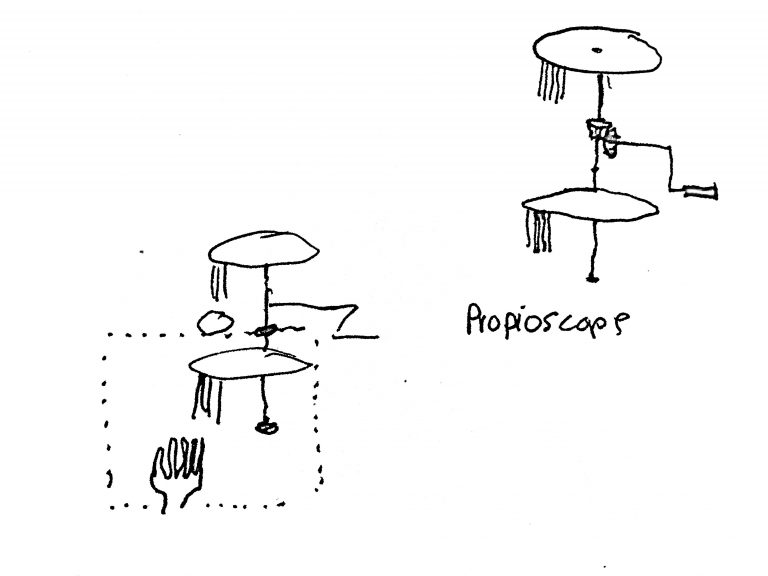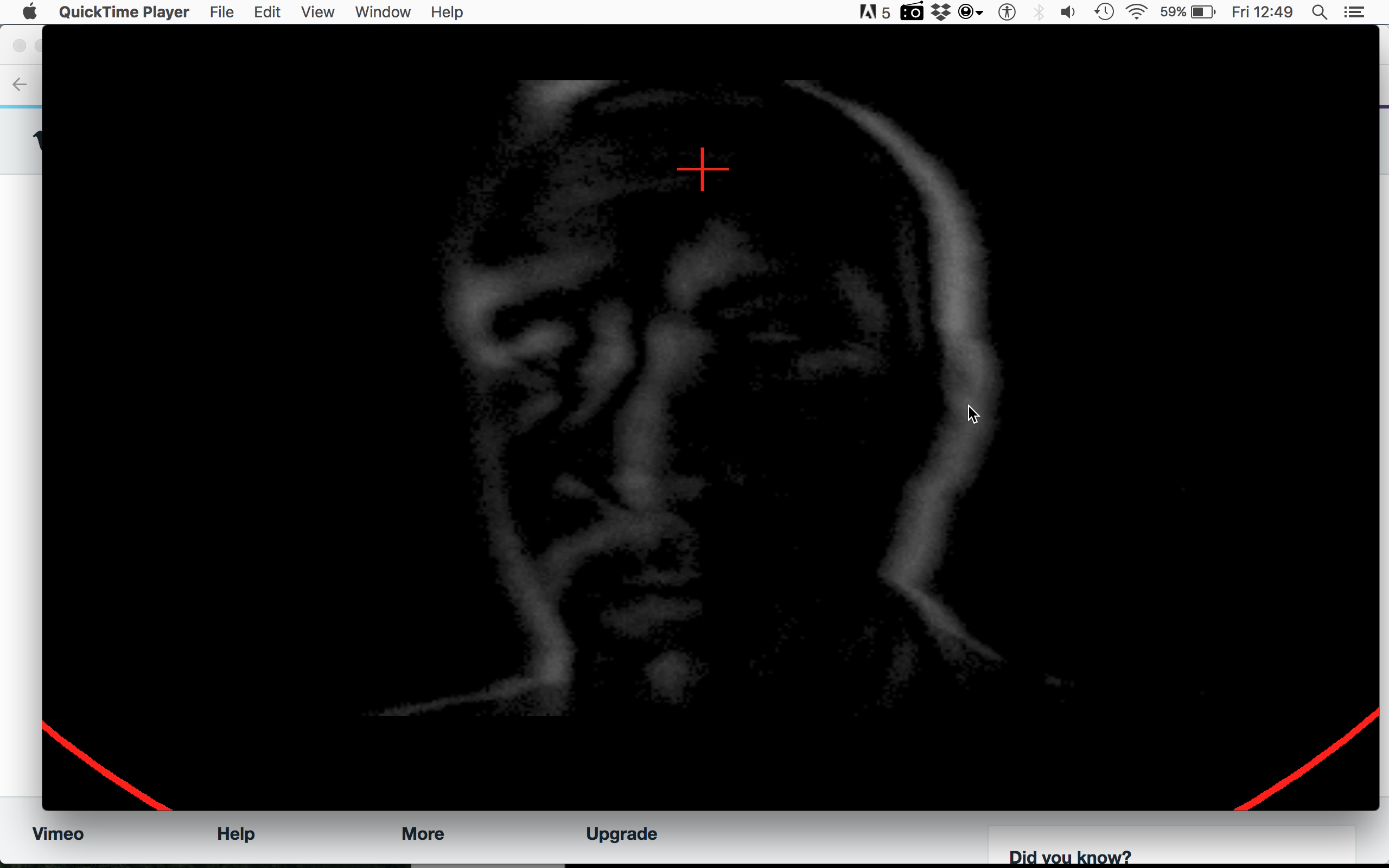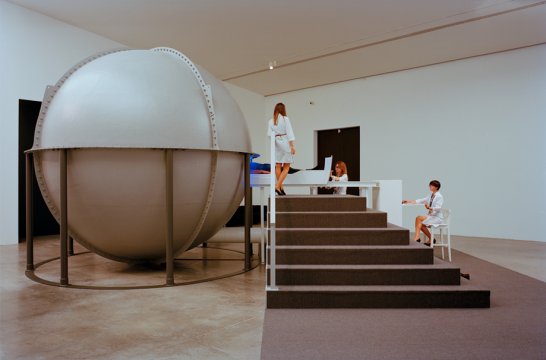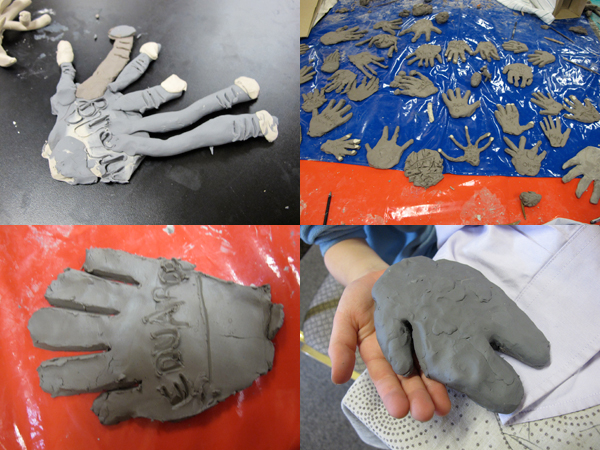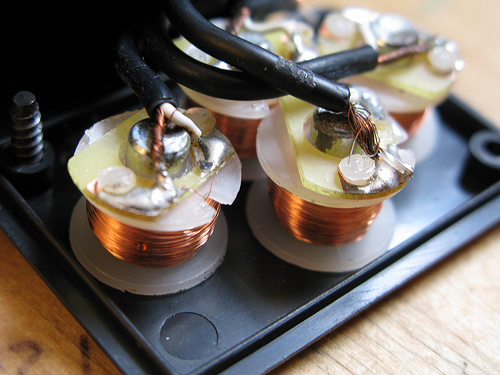I'm doing a workshop related to my research, perceptual illusions and altering perception through experiments, Clay hand illusion and other activities based on sound and light and taste, at Radiona Zagreb, 21-22/04/2018 https://radiona.org/ check out the web Re-mapping the senses workshop page and resources here...
Tag: illusion
Fish-brain-machine
As part of my Enki exhibition at Kapellica Gallery in Ljubljana 2012, I developed a related perceptual illusions and brain hacks workshop with Marc Dusseiller [Hackteria], as part of the gallery’s Biotech program. We came up with the idea to make a special issue circuit for the workshop and we set to work designing a circuit the encapsulated the Enki project in miniature. After a couple late nights, we came up with this super cool PCB design. Marc worked hard to create a fully functional efficient design, which was also aesthetically pleasing. The outline of the fish is also the ground in the circuit. This has to be the most ultra minimal brain-machine available to build. 6 components. We spent further
Strange face illusion with two-way Mirror feedback
“… a quiet room dimly lit by a 25 W incandescent light. The lamp was placed on the floor behind the observer so that it was not visible either directly or in the mirror. A relatively large mirror (0.5 m60.5 m) was placed about 0.4 m in front of the observer. The luminance of the reflected face image within the mirror was about 0.2 cd mÿ2 and this level allowed detailed perception of fine face traits but attenuated colour perception…The task of the observer was to gaze at his/her reflected face within the mirror. Usually, after less than a minute, the observer began to perceive the strange-face illusion…” Giovanni B Caputo, Perception, 2010, volume 39, pages 1007 – 1008 2010
Mechanically Augmented Reality
When I first learned about the Rubber hand illusion [RHI] I immediately began to think about ways in which the process could be automated to create an artwork, in which the experimenter's presence was removed. This could be done using sensors and a microcontroller to articulate solenoids to tap fingers for example. That thought train was on a back burner until discovered the work of fellow MMU PGR Lin Charlston. As part of her PhD research [See her profile here 'The Multimodal book as organism, artefact and assemblage: non-human agency in processes of growing and making'] She invented a beautifully simple, entirely mechanical device just to do exactly this. Your hand is placed inside a box, while the other hand turns a crank. On top of the box, another rubber hand
On the embodiment of unfeasible objects
Further to my last post detailing experiments relating to the embodiment of invisible and even third hands, here are some notes on my first 'Clay hand Illusion' experiments... The ‘Rubber hand illusion’ shows it is possible to convince participants that a rubber hand is their own by placing it in front of them while stroking it in the same way as their hidden real hand. The use of self-made clay hands, or objects [see below] in place of the rubber hand raises several interesting possibilities for exploration, which move away from the embodiment of replica body parts, and towards the possible embodiment of modified body parts, or completely 'unfeasible' objects.The clay allows for the gradual and immediate morphing of forms and for the
Illusions of Invisible, alien hands, 3 arms, and shrinking bodies…
I have previously posted about the original 'rubber hand illusion' in which participants are convinced a fake rubber hand is their own. A classic low tech experiment that can help us "understand how sight, touch and “proprioception” the sense of body position, combine to create a convincing feeling of body ownership, one of the foundations of self-consciousness (Nature 1998, vol 391, p 756 )” Further to this research recent studies have gone on to experimentally induct of out of body experiences or create body swap illusions. [ Henrik Ehrsson and Olaf Blanke http://www.eurekalert.org/pub_releases/2007-08/ucl-foe081407.php ] Between these two experiments, several interesting versions of hand-related experiments also exist which demonstrate the plasticity of our body perception... The Alien Hand Experiment first created in the 1960s predates the Rubber hand experiment, seems more 'trick'
Blind drawing of hand
Blind drawing of hand starting from the left and using a continuous line, before and after experiments. Could this exercise be used as a measure of "proprioceptive drift" before and after 'Rubber hand illusion' type experiments? I will be exploring this idea soon with the research group at BEAM lab...
Clay hand drawings
Here are are a selection of drawn outlines of clay hands created by workshop participants aged 6 to 12 for the original clay hand experiment (see posts tagged rubber hand or clay hand) Participants of all ages were asked to create a hand and use it in place of a replica rubber hand, the idea was to test if a self-created hand was easier to connect with. The hands were then taken and worked on further, sometimes becoming more distorted and abstract.
Face as Interface
Trying to create a simple motion tracking patch using PD_extended and Gem, I came across this project by Elektro Moon Vision http://elektromoon.co.nr/ the mini App provides OSC data from movements such as eyebrows, nose, mouth, orientation scale etc. This is massively useful for an experiment I have in mind related to the "strange face in the mirror illusion" The data can be captured and used to control a 3D model in virtual space for example. Matching rotation, scale and orientation to the model and the movement of my head... This is a simple motion detection patch that tracks the difference between two frames creating ghostly outlines of momentarily disembodied features. It's sensitive enough to pick up facial expressions such as the movement of muscles and
Drawing a strange face in the dark
Shortly after my experience of the "Strange face in the mirror experiment" I made these drawings in low light conditions as a way of recording the perceivable elements of my face and shape of the head. The particles of carbon and graphite reflect well the visual noise, like static, one experiences in the experiment. These drawings don't illustrate the hallucinations I experienced [these will follow] "staring at one's own reflection in a mirror in a darkened room for some time can induce vivid hallucinations. For purposes of research, I had to try it" My experience of the ‘strange face illusion’... For my description of my experience of the 'strange face', illusion see here... "staring at one's own reflection in a mirror in a darkened room for
Rubber hands ‘feel’ touch that eyes see
The first report on the Rubber Hand illusion. Published in Nature in 1998 by Matthew Botvinick, and Jonathan Cohen of the Department of Psychiatry, University of Pittsburgh... "We report here an illusion in which tactile sensations are referred to an alien limb. The effect reveals a three-way interaction between vision, touch and proprioception, and may supply evidence concerning the basis of bodily self-identification." "It has been proposed that the body is distinguished from other objects as belonging to the self by its participation in specific forms of intermodal perceptual correlation7,8. Subjects in our first experiment who referred their tactile sensations to the rubber hand also consistently reported, in both sections of the questionnaire, experiencing the rubber hand as belonging to themselves. Indeed,
James Turrel – Light Reignfall
[vimeo 75419053 w=640 h=360] James Turrell's Light Reignfall @LACMA - Andrew van Baal James Turrell's Light Reignfall Light Reignfall is a work from his series of perceptual cells, inside the participant is exposed to a uniform homogenous field of modulated light. A combination of sensory overstimulation, yet deprived of recognisable forms or space, hallucinatory effects are experienced. “Assisted by an attendant, an individual viewer enters a spherical chamber on a sliding bed. A program of saturated light (operated by a technician) surrounds the viewer for twelve minutes, allowing the visitor to experience the intense, multi-dimensional power of light and the complex seeing instrument of the human eye.” "James Turrell (b. 1943, Los Angeles), a key artist in the Southern California Light and Space movement
God Helmet
Neurologist Michael Persinger created the God Helmet, an actual helmet modified with electrical coils that can create electromagnetic fields in the wearer's temporal lobes that induces "religious" experiences in the people who put it on. "This is a device to investigate whether religious, spiritual, and mystical experiences had a natural rather than a supernatural source. He speculates that we are somehow programmed so that they can generate religious experiences via our brain's internal processes." I was interested in this experiment because of its use of sensory deprivation and the fact it would be relatively easy to recreate [see my DIY neurostimulation attempt 2009] for my Enki project. My plan was to drive it with frequencies generated by my electric fish [a low
Auditory illusion
Diana Deutsch developed some fascinating auditory illusions. These include the phenomenon of 'speech to song' whereby repeating loops of spoken word suddenly begin to sound like a song. In another illusion, 'phantom words' new words emerge from repeating fragments of words. To experience these all you need are headphones as the a stereo effect is essential, here is the link to her work.… Speech to song http://deutsch.ucsd.edu/psychology/pages.php?i=212 Phantom Words http://deutsch.ucsd.edu/psychology/pages.php?i=211 https://www.youtube.com/watch?v=EWzt1bI8AZ0 A nice example of sine wave speech from Joe Banks [Disinformation] has written about psychoacoustics in his book https://rorschachaudio.com/ I was lucky to meet him at The Sensorium of Animals workshop. "The McGurk effect" is a perceptual illusion that mixes a sound with the visual cue of a different sound, We see the mouth move and hear/see a mismatched sound, check out what happens... https://www.youtube.com/watch?v=aFPtc8BVdJk https://www.youtube.com/watch?v=7uHDMc4TEU8 This
My experience of the ‘strange face illusion’
I had read about this experiment by which staring at one's own reflection in a mirror in a darkened room for some time, can induce vivid hallucinations. For purposes of research, I had to try it. I found my bathroom could meet the following requirements... "... a quiet room dimly lit by a 25 W incandescent light. The lamp was placed on the floor behind the observer so that it was not visible either directly or in the mirror. A relatively large mirror (0.5 m60.5 m) was placed about 0.4 m in front of the observer. The luminance of the reflected face image within the mirror was about 0.2 cd mÿ2 and this level allowed detailed perception of fine face traits but
Inverted vision experiments
An early experiment in 'perceptual plasticity' was conducted by Psychologist George Stratton in1896. He used his inverted vision goggles, over a period of 8 days, and over time adapted to the point where he was able to function normally. When the glasses were removed, it took some time for him to adapt back to seeing the world as normal without them. See also A lesser-known experiment over three days in 1899 used a set of mirrors to view his whole body as if tilted by 90 degrees. He describes interesting motor control anomalies and even an experience which he describes as an 'out of body experience'. Currently, I am searching for more information and documentation on this experiment. Theodor Erismann (1883-1961) and Ivo Kohler
Rubber-hand illusion experiment
As part of my research into perceptual illusions, I looked into The ‘Rubber Hand Experiment’. This is a classic low tech experiment that can help us "understand how sight, touch and “proprioception” the sense of body position, combine to create a convincing feeling of body ownership, one of the foundations of self-consciousness (Nature 1998, vol 391, p 756 )”. Recent studies have gone on to experimentally induct of out of body experiences or create body swap illusions. See the work of Henrik Ehrsson and Olaf Blanke. [see link http://www.eurekalert.org/pub_releases/2007-08/ucl-foe081407.php ] I invited some psychologists to the studio [including Lizzi Lewis of BEAM Lab and Paul Sermon] who I have expertise in this area, they brought presentations and some kit to
Clay hand experiment #1
Working again with Lizzi Lewis of BEAM Lab and Manchester Science Museum we developed a workshop based on the 'Rubber Hand Experiment'. As we had to work with a large number of people and we didn't have funding to get loads of rubber hands. So we made the hands in the workshop with clay and used gloves full of different materials, sand, gel, lentils, etc. This had some interesting outcomes, that warranted further research... As you can see the hands were diverse in form, for the illusion to be effective the hand does not need to be true to life necessarily. Some hands were made purposefully alien for experiments and seemed to work effectively. I wondered if participants are more likely
DIY Neuro stimulation
Reposted from my other blog 2009... I think the discussion around Michael Persinger's God helmet experiment was really interesting. I had to act on this and investigate the realm of experimental psychology further. I got in touch with him to ask some questions about the technology and the experimental process. I asked if I could make an array electromagnetic coils with oscillating magnetic field could generate similar effects. Which he seemed to think was feasible. I decided to make a modified version of the god helmet to work with my Enki interface. Here is a view my DIY neuro-stimulation device there are 4 coils which oscillate with magnetic frequencies, I have been using MAX MSP to drive these using electrical pulses derived from the
Enki interface 2006-2013
This project formed the basis for my PhD proposal. Initially, it was an investigation into the behaviour of electric fish, which have the ability to navigate and communicate using electro-perception. I investigate ways in which to communicate and interact with them. , I soon started to become interested more widely in perceptual and psychological experiments with humans; themes of interconnectedness, extending sensory perception. More specifically a notion of the 'body as electric image'. " The ENKI project was developed through an Arts Council, International Artists Fellowship, Pepiniere programme, Paris, with Centre National de la Recherche Scientifique (CNRS) France in 2006. It has been shown in the UK Europe including, Dutch Electronic Arts Festival, NL, CAAC, Seville, Spain 2007. International Festival of Art /Science
ENKI exhibition at Kapellica Gallery
10/2012– 01/2013 Enki [Solo show] Kapellica Gallery, Ljubljana, Slovenia Enki experiment 5 Possibly the final showing of the ENKI project ENKI is a series of experiments in bio-interfacing between humans and certain types of Electrogenic Fish .. Ultimately this is achieved through psycho-acoustic audio and visual entrainment as a means of modulating human emotional state. During this process, bio-electrical activity is monitored and used as a means to create a feedback loop between organisms. The research aims to study the interaction between tiny bio-electrical fields of both species [human and fish] specifically the way in which these fields modulate and the means of controlling them. It also aims to discover if it is possible to create a harmonious state of interaction that can
Amplitude Modulation Workshop
I met Martin Howse in 2009 when he invited me to do a workshop for his micro research series in Berlin. At the time he had a fantastic apartment with a large garage space for a studio. The large table at its centre became sprawled with electronics by the end of the day. I had the opportunity to take a look at some of his projects, wonderful hand-drawn circuits burnt and encrusted that looked more like remnants from some other device of unknown function. For this workshop we investigated Amplitude Modulation, turning light into sound, use of the LM chips as an amplifier and using light sensors as an input, and making LEDs and lasers transmit sounds and signals through light


